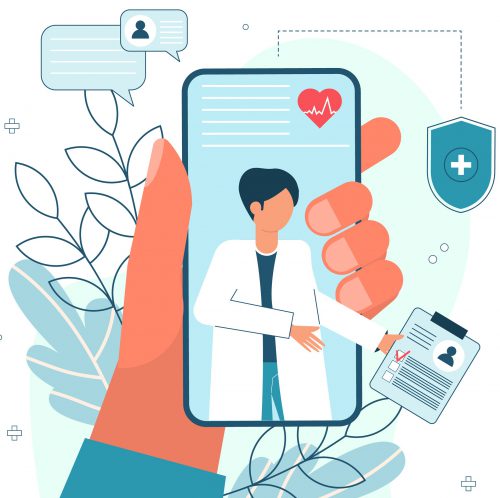New national guidelines on telerehabilitation
 This article has been published on December 9, 2021 on Agenda Digitale, within our Legal Health section (Italian)
This article has been published on December 9, 2021 on Agenda Digitale, within our Legal Health section (Italian)
Rehabilitation is one of the activities that has suffered the most significant limitations because of the pandemic and the measures that have been adopted to cope with it. Starting from this assumption, telerehabilitation represents a tool to mitigate these difficulties and improve patient access to treatment.
Last October, the State-Regions Conference (the “Conferenza Stato Regioni”) approved a document submitted by the Ministry of Health containing national guidelines for the delivery of telerehabilitation services by healthcare professionals. The national guidelines on telemedicine issued at the end of 2020 had previously indicated that such guidelines on telerehabilitation were to be provided. Other guidelines, concerning tele-certification and telemonitoring are expected to be issued in the next months.
What is telerehabilitation?
Telerehabilitation is defined as the remote delivery of services aimed at enabling, restoring, improving, or otherwise maintaining the psychophysical function of people of all ages with disabilities or disorders—whether congenital or acquired, temporary or permanent—or at risk of developing them.
It is therefore an activity that is the responsibility of health professionals and includes the remote assessment of the correct use of aids, orthoses, and prostheses during normal everyday activities carried out in the home or work environment.
Within telerehabilitation, healthcare professionals’ activities include prescribing, performing, controlling, monitoring, supervising, and modifying services and evaluation services delivered remotely through digital means.
What is the purpose of this document?
The document aims to provide uniform guidelines applicable nationwide for the delivery of remote services with particular regard to rehabilitation treatments to be performed with digital health tools.
Following Conferenza Stato-Regioni approval, these national indications will be implemented within the various regional health organizations, and information flow regarding supply/reporting of outpatient specialist activities to keep track of rehabilitation services and performance will be adapted accordingly.
Requirements for the delivery of telerehabilitation services
In addition, the document in question reiterates some important aspects relating to the delivery of such services. These can also be read in the national guidelines on telemedicine that presented the larger framework, but it is useful to have them available again in this context as well:
- telerehabilitation services that can be provided to each patient must be included in the Individual Rehabilitation Project (IRP)—as provided by the Conferenza Stato-Regioni Agreement of February 10, 2011—in an Individual Treatment Plan (ITP)—as provided by the Conferenza Stato-Regioni Agreement of January 24, 2013—or in an Individual Assistance Project (IAP)—as per Article 22 of the Prime Ministerial Decree (the “DPCM”) of January 12, 2017;
- structures that intend to provide telerehabilitation services funded by the National Health Service must be accredited (and under contract) for those same activities (including the method used to provide the service);
- facilities that intend to provide telerehabilitation services privately must have medical authorization to carry out said activities;
- the pricing of remote services will be equivalent to that for similar services provided in person; naturally, pricing methods must be consistent with the remuneration system designed for various care settings (e.g., outpatient clinics, integrated home care, long-term care units, and rehabilitation facilities);
- technologies shall be used in compliance with the regulations in force with particular reference to (i) legislation on the protection of personal data and related security measures (data must be protected by encryption techniques); (ii) legislation on medical devices that requires that hardware and software devices used are suitable and certified for their intended uses;
- informed consent from the patients concerned is required, and said consent must specify, as indicated in the national guidelines, how the service is used (remotely) and what this implies, what the differences are, and any risks.
Liability
Undoubtedly, the use of these technologies raises liability issues. Beyond the liability related to the performance of any healthcare services, which is similar to the scenario for in-person services (see Law no. 24/2017 on healthcare liability), the use of digital technologies expands risk further, and therefore additional attention is required. As examples, think of the security issues related to sharing and circulating health data, or the risks that arise when devices turn out to be unsuitable or non-functional.
It is therefore important that these new tools be implemented by competent and trained personnel and that there be adequate supervision and control of the activities. This is also necessary to ensure that the remote service offers quality and effectiveness equivalent to that of the in-person service (to avoid having to repeat performance of the service, at greater cost to the National Health system). Therefore, training is also highlighted in this document.
Further challenges
The document emphasizes the need to set up an adequate training course for healthcare professionals involved in these activities. In particular, it is considered important for each health facility to include in its training plan specific rehabilitation training activities. These are to be provided to personnel involved in delivery of these services (employees of both public and private facilities). Staff training and education must be assessed by the relevant Local Health Authority. Indeed, cultural and training aspects are of primary importance in guaranteeing effective distribution of telemedicine activities throughout the national territory.
Moreover, it is clear that this document is by its very nature provisional and destined to become obsolete in a short time. The document mentions that the indications contained therein are to be updated periodically, including as a reflection of technological evolution, to guarantee that it continues to improve and its potential continues to expand.
